Municipal corporation in Uttarakhand, India
| Rishikesh | |
|---|---|
| Municipal corporation | |
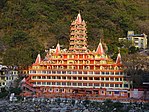 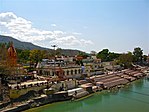   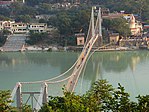 Left to Right; Top to Bottom : Triambakeshwar Temple, Muni Ki Reti, Parmarth Niketan, Janki Setu, Evening aarti at Triveni Ghat, the Ram Jhula and AIIMS Rishikesh Left to Right; Top to Bottom : Triambakeshwar Temple, Muni Ki Reti, Parmarth Niketan, Janki Setu, Evening aarti at Triveni Ghat, the Ram Jhula and AIIMS Rishikesh | |
| Nickname(s): Yoganagari and Yognagari | |
  | |
| Coordinates: 30°06′30″N 78°17′50″E / 30.10833°N 78.29722°E / 30.10833; 78.29722 | |
| Country | India |
| State | Uttarakhand |
| District | Dehradun and Tehri Garhwal |
| Municipality | 1952 |
| Named for | Hrishikesha |
| Government | |
| • Type | Mayor–council |
| • Body | Rishikesh Municipal Corporation |
| • Mayor | Anita Mamgain (BJP) |
| • Municipal Commissioner | Rahul Kumar Goyal |
| Area | |
| • Total | 11.5 km (4.4 sq mi) |
| Elevation | 340 m (1,120 ft) |
| Population | |
| • Total | 102,138 (urban agglomeration) 70,499 (City as per Census 2,011) |
| • Rank | 7th |
| • Density | 8,851/km (22,920/sq mi) |
| • Male | 54,446 |
| • Female | 47,672 |
| Languages | |
| • Official | Hindi |
| • Native | Garhwali |
| Time zone | UTC+5:30 (IST) |
| PIN | 249201 |
| Telephone code | +91-135 |
| Vehicle registration | UK-14 |
| Literacy (2011) | 86.86% |
| • Male | 92.21% |
| • Female | 80.78% |
| • Rank | 2nd |
| Sex ratio (2011) | 875 ♀ / 1000 ♂ |
Rishikesh, also spelt as Hrishikesh, is a city near Dehradun in the Indian state Uttarakhand. The northern part of Rishikesh is in the Dehradun district while the southern part is in the Tehri Garhwal district. It is situated on the right bank of the Ganges River and is a pilgrimage town for Hindus, with ancient sages and saints meditating there in search of higher knowledge. There are numerous temples and ashrams built along the banks of the river.
It is known as the "Gateway to the Garhwal Himalayas" and "Yoga Capital of the World". The city has hosted the annual International Yoga Festival on the first week of March since 1999. Rishikesh is a vegetarian-only and alcohol-free city.
The Tehri Dam is located 86 km (53 mi) away from Rishikesh. Uttarkashi, a popular yoga destination, is 170 km (110 mi) uphill on the way to Gangotri. Rishikesh is the starting point for traveling to the four Chota Char Dham pilgrimage places: Badrinath, Kedarnath, Gangotri, and Yamunotri. It is also a starting point for Himalayan tourist destinations such as Harsil, Chopta, Auli, as well as summer and winter trekking destinations like Dodital, Dayara Bugyal, Kedarkantha and Har Ki Dun.
In September 2015, Indian Minister of Tourism Mahesh Sharma announced that Rishikesh and Haridwar would be the first "twin national heritage cities". As of 2021, Rishikesh has a total population of 322,825 within the tehsil including the city and its 93 surrounding villages.
The city is governed by Rishikesh Municipal Corporation and tehsil.
Etymology
IAST: "Hṛṣīkeśa" (Sanskrit: हृषीकेश) is a name derived from Vishnu, composed of hṛṣīka meaning 'senses' and īśa meaning 'lord' for a combined meaning as 'Lord of the Senses'. The name commemorates an apparition of Vishnu to Raibhya Rishi, as a result of his tapasya (austerities), as Hrishikesha. In the Skanda Purana, this area is known as Kubjāmraka (कुब्जाम्रक), as Vishnu appeared under a mango tree.
History
Rishikesh was part of the legendary "Kedarkhand" mentioned in the Skanda Purana. Legends state that Rama did penance here for killing Ravana, the asura king of Lanka. Lakshmana, Rama's younger brother, crossed the Ganges using two jute ropes at the point where the present Lakshman Jhula (लक्ष्मण झूला) suspension bridge stands today. Lakshman Jhula also collapsed in 2020. And a much stronger, second in the whole of India, a glass bridge, is being built across the river. The 248-foot long iron-rope suspension bridge built in 1889 was washed away by flooding in 1924. In 1927, it was replaced by the current, stronger bridge built by the United Provinces Public Works Department, connecting the Tapovan, Tehri, and Jonk, Pauri Garhwal districts. A noted suspension bridge named Ram Jhula was built in 1986 at the nearby Sivananda Nagar. The Skanda Purana also mentions the site as "Indrakund" where Indra underwent a holy bath to remove a curse.
The Gazeteer of Dehradun, written by Indian Civil Service officer HG Walton, describes the site as "beautifully situated on the right bank of the Ganges, on a high cliff overlooking the river. The place is developing very rapidly, especially since the construction of the new bridge over the Song River, the realignment of the pilgrim road from Raiwala to Rishikesh."
The Ganges, one of the most sacred rivers to Hindus, flows through Rishikesh in its course from the Shivalik Hills of the Himalayas to the plains of northern India with temples built along the banks Shatrughna Mandir, Bharat Mandir, and Lakshman Mandir are the ancient temples established by Adi Shankaracharya. Shatrughna Temple is near the Ram Jhula suspension bridge, while Lakshman Mandir is situated near the Lakshman Jhula suspension bridge.
The historical records mention that some pilgrims used to stay at Rishikesh, either seeking the site itself or using it as a resting place before moving onwards to the Himalayas. In the transition to a modern tourist town, local markets have evolved from commercializing goods such as local and religious handicrafts to a service-oriented tourist industry with provision stores, cafes, hotels, sites for rafting, and centers for yoga and meditation.
Geography

Rishikesh is at 30°06′12″N 78°17′41″E / 30.103368°N 78.294754°E / 30.103368; 78.294754. It has an average elevation of 340 metres (1,120 ft). The town is located in the Tehri Garhwal region of the northern Indian state of Uttarakhand.
After flowing 249 km (155.343 mi) through narrow Himalayan valleys, the Ganges emerges at Rishikesh before debouching onto the Gangetic Plain at the pilgrimage town of Haridwar. Despite the pollution of the Ganges, the water in Rishikesh is relatively unaffected, as the major polluting points are down river in the neighbouring state of Uttar Pradesh.
According to the Köppen-Geiger climate classification system, its climate is humid subtropical (Cwa). The average maximum temperature is 40 °C (104 °F). The average minimum temperature is 7 °C. The wettest month is July with the highest rainfall of 444 mm. The driest month is November with rainfall of 10 mm. Months of May, June, July, and August have the highest UV index of 12, and January and December have the lowest UV index of 4.
| Climate data for Rishikesh | |||||||||||||
|---|---|---|---|---|---|---|---|---|---|---|---|---|---|
| Month | Jan | Feb | Mar | Apr | May | Jun | Jul | Aug | Sep | Oct | Nov | Dec | Year |
| Mean daily maximum °C (°F) | 17 (63) |
22 (72) |
29 (84) |
35 (95) |
39 (102) |
38 (100) |
33 (91) |
32 (90) |
32 (90) |
30 (86) |
25 (77) |
20 (68) |
29 (85) |
| Mean daily minimum °C (°F) | 5 (41) |
8 (46) |
14 (57) |
18 (64) |
23 (73) |
25 (77) |
25 (77) |
24 (75) |
23 (73) |
15 (59) |
9 (48) |
6 (43) |
16 (61) |
| Average precipitation mm (inches) | 51 (2.0) |
33 (1.3) |
34 (1.3) |
9 (0.4) |
20 (0.8) |
94 (3.7) |
482 (19.0) |
495 (19.5) |
219 (8.6) |
76 (3.0) |
9 (0.4) |
17 (0.7) |
1,539 (60.7) |
| Average rainy days | 3 | 2 | 3 | 1 | 2 | 7 | 15 | 16 | 8 | 2 | 0 | 1 | 60 |
| Mean daily sunshine hours | 6 | 7 | 8 | 9 | 9 | 7 | 6 | 6 | 7 | 8 | 8 | 7 | 7 |
| Source: Weather2Travel | |||||||||||||
Rishikesh has been ranked 31st best “National Clean Air City” under (Category 3 population under 3 lakhs cities) in India.
Civic Administration
The Rishikesh Municipal Corporation has administered the city's 40 wards since the 2018 incorporation of the urban local body. Each ward had between 2,300-3,000 residents during the 2018 assessment. Rishikesh belongs to the Haridwar Lok Sabha constituency. The first and the current mayor of the corporation is Anita Mamgain. The current Municipal Commissioner, commonly known as Nagar Aayukt locally, is Narendra Singh.
Demographics
See also: List of cities in Uttarakhand by populationAs per provisional data of 2011 census, Rishikesh had a population of 102,138, out of which males were 54,466 (53%) and females were 47,672 (47%). The literacy rate was 86.86% compared to the national average of 74.04%.
Environment and Ecology
Rishikesh, though known for its natural beauty and spiritual significance, has been facing several environmental challenges due to increasing tourism and urbanization.
Water Pollution
The Ganges River, which emerges from the Himalayas at Rishikesh, faces significant pollution issues. Despite being relatively unaffected by pollution at its source, the river shows high levels of contamination in the urban stretches of Rishikesh and Haridwar. A study by Doon University found "very high presence of pollutants" in these areas, including anti-inflammatory drugs, antibiotics, and other pharmaceutical compounds.
Air Quality
Rishikesh also faces significant air quality challenges despite its spiritual and natural significance. The Central Pollution Control Board (CPCB) regularly monitors the city's ambient air quality through the National Air Quality Management Programme (NAMP). The primary pollutant of concern is Particulate Matter (PM10), which consistently exceeded prescribed national standards from 2012 to 2017, while Sulfur Dioxide (SO2) and Nitrogen Dioxide (NO2) levels remained within limits. Major sources of air pollution for Rishikesh include road dust, vehicular emissions, domestic fuel burning, open waste burning, and construction activities. Rishikesh has implemented several mitigation measures. As of 2018, the city had 3,098 diesel-driven commercial vehicles over 15 years old, with plans to ban such vehicles and increase the number of pollution emission checking centers from 10 to 30. Other efforts include increased surveillance of vehicle pollution levels, implementation of the "Uttarakhand Anti Littering and Anti Spitting Act 2016", and fines for burning municipal waste. Despite these initiatives, Rishikesh continues to struggle with bringing PM10 levels within prescribed limits, indicating the need for more stringent air pollution control strategies.
Waste Management
The rapid growth in tourism has strained Rishikesh's waste management systems. Inadequate waste disposal and lack of proper recycling facilities have led to the accumulation of non-biodegradable waste in and around the city. There is a big landfill/trenching ground that is situated in the middle of the city in Govindnagar. This landfill site has been a source of environmental concern for various reasons. As per an estimate from 2021, the city generates approximately 1,800 metric tonnes of waste monthly, including 700 tonnes of wet waste, 500 tonnes of dry waste, and 600 tonnes of mixed waste. The high proportion of mixed waste has been causing difficulties in ensuring proper waste segregation at the source. The landfill's central location poses environmental and health risks, potentially contributing to soil and groundwater pollution, as well as attracting disease-carrying pests. Studies in nearby areas have revealed elevated levels of heavy metals in groundwater, making it unsuitable for drinking. The accumulation of legacy waste is a significant issue, prompting the installation of a legacy waste treatment plant at the Govindnagar trenching ground in recent years. While efforts are being made to improve waste management, the landfill's central location remains a major environmental and public health concern for Rishikesh, a city renowned for its spiritual and touristic appeal.
Tourism
In the 2021-2022 fiscal year, Rishikesh had the highest revenue per hotel room among Indian tourist leisure destinations with an average of ₹10,042 per night. Only four tourist places in India attract more foreign tourists than Rishikesh. The town is one of the favorites of Israeli tourists, who often come here after completing their mandatory IDF service.
Yoga "capital"
Further information: Yoga tourism and Postural yoga in IndiaAlthough Rishikesh has always been a popular tourist destination due to its status as the birthplace of yoga, the city gained more notoriety when the Beatles visited in 1968. Since ancient times, the location has served as a haven for yogis, saints, and practitioners who come there to learn about this traditional Indian practise, advance their understanding of it, become instructors, or even find enlightenment.

In February 1968, the Beatles visited Maharishi Mahesh Yogi's ashram in Rishikesh, attracted by his Transcendental Meditation. The Beatles composed numerous songs during their time at the ashram, many of which appear on the band's self-titled double album, also known as the "White Album". Western fans arrived seeking similar experiences, resulting in new yoga and meditation centers that fueled Rishikesh's nickname as the "Yoga Capital of the World". Many of these Westerners have undergone training to become certified yoga teachers.
The city's Sivananda Nagar houses the Sivananda Ashram and Divine Life Society, founded by Swami Sivananda. The Ram Jhula and Lakshman Jhula suspension bridges are accompanied by temples with additional ashrams near Swargashram along the eastern riverbank. Neelkanth Mahadev Temple is located in the forest, 28 km (17 mi) from Rishikesh, while Vashishtha Guha, a cave used by the sage Vashishtha, is 21 km (13 mi) north of the area.
Activities

The Ganga Aarti (also known as Maha Aarthi) is performed at dusk at the Triveni Ghat. This popular Hindu religious ritual involves playing music and providing religious offerings to the fire.
In 1939, the British completed construction on a 137 m (450 ft) long iron suspension bridge on the Ganges River at the spot where Lakshman (Rama's brother) crossed the Ganges on a jute rope.

Rishikesh offers many rafting options along the Ganges from Grades I-IV. Rishikesh has India's highest bungee jumping at 83 m (272 ft) over a rocky cliff. The longest flying fox (also known as a zipline) in Asia is in Rishikesh with a length of 1 km and speeds of 140 km per hour.
Impact of camps and adventure activities on River Ganga
According to environmental activists, "These camps are not only in violation of Forest (Conservation) Act 1980, but also the Environment (Protection) Act 1986, as well as the Water (Prevention and Control of Pollution) Act 1974, as it is leading to pollution of Ganga by discharging effluent, throwing of solid waste directly and adversely affecting the ecological integrity of the river system."
Environmental activists allege that these camps, which are established as temporary sites, do not have adequate sewage and sanitation facilities, disturb the habitat of wild animals, and "affect the peace, tranquility, and serenity of the forest area. At the campsites, the camp owners permit employees and the visitors to have food and alcohol. They leave empty bottles, cans, unconsumed food and waste including bones and filth in and around the campsite."
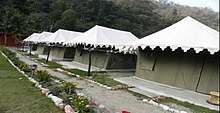
In a 2008 study on the beach camps between Kaudiyala and Rishikesh, experts from the Govind Ballabh Pant Himalayan Environment and Development Institute—R. K. Maikhuri, Nihal Farukhi and Tarun Budhal—found that wildlife conservation standards and norms, particularly for waste management, were routinely disregarded.
A bench headed by the National Green Tribunal chairperson Justice Swatanter Kumar on 1 April 2015 heard a plea filed by the non-governmental organisation Social Action for Forest and Environment (SAFE). The National Green Tribunal has sought explanations from the Government of India and the Government of Uttarakhand on the "unregulated" operation of rafting camps on the banks of Ganga between Shivpuri and Rishikesh in Uttarakhand. The state government has assured the tribunal that it would not grant permission to any new camp till the next hearing in May.
As the seriousness of issue "The National Green Tribunal," a bench headed by Justice U. D. Salve has rejected permission to rafting camps operating in Rishikesh and slammed the Ministry of Environment and Forests and the Government of Uttarakhand for not filing their replies in the case and directed them to file their response.
Healthcare
See also: All India Institute of Medical Sciences RishikeshAIIMS Rishikesh is one of the six healthcare institutes being established by the Ministry of Health and Family Welfare, Government of India under the Pradhan Mantri Swasthya Suraksha Yojana (PMSSY) with the aim of correcting regional imbalances in quality tertiary level healthcare in the country and attaining self-sufficiency in graduate and postgraduate medical education and training.
The first AYUSH (Ayurveda, Yoga, Unani, Siddha and Homoeopathy) Centre was opened in Rishikesh on 4 June 2015 by Shripad Yasso Naik, the Minister for Yoga and Traditional Medicine, to sponsor new research in these alternative medicine systems.
Transport
Rail
The Rishikesh and the Yog Nagari Rishikesh railway stations offer service to this city, partially through Indian Railways. A new railway line, connecting Rishikesh with Karnaprayag, is under construction.
Road
Rishikesh is connected with the state capital, Dehradun, which is 45 km from the city. Private and shared taxi services travel between Rishikesh and most major north Indian cities like Delhi, Chandigarh, and Shimla.
Air

The nearest Airports are Dehradun Airport (15 km) and New Delhi International Airport (240 km).
Effect on spiritual environment
The tourism sector has brought tourists illegally importing cannabis and alcohol. Incidents like partial nakedness and drug paraphernalia littered along beaches is producing criticism that Rishikesh is losing its spirituality.
The riverside has spiritual and religious significance because it represents the emergence of the Ganges after the confluence of the Bhagirathi and Alaknanda rivers at Devprayag in the Garhwal Himalayas. Saints and yogis have been meditating on the banks of Ganges since antiquity.
Gallery
-
 Tera Manzil Temple
Tera Manzil Temple
-
NeelKanth Mahadev Temple
-
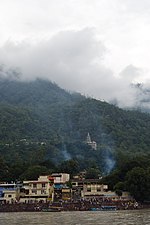 Ghats by the River Ganges
Ghats by the River Ganges
-
 Ram Jhula Bridge across the Ganges at Muni Ki Reti, built in the 1980s
Ram Jhula Bridge across the Ganges at Muni Ki Reti, built in the 1980s
-
 A Hanuman temple in Rishikesh
A Hanuman temple in Rishikesh
-
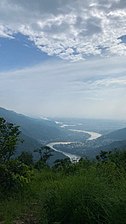 Rishikesh Views
Rishikesh Views
-
 Lakshman Jhula
Lakshman Jhula
-
 View of Rishikesh
View of Rishikesh
-
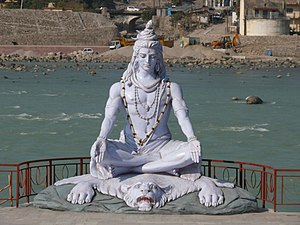 Shiva statue near Parmarth Niketan which was washed away by the 2013 flood on River Ganga
Shiva statue near Parmarth Niketan which was washed away by the 2013 flood on River Ganga
See also
References
- ^ Ghose, Aruna, ed. (2011). "Rishikesh". DK Eyewitness Travel Guide: India. DK. p. 184. ISBN 978-0-75667-026-9. ISSN 1542-1554. Archived from the original on 24 March 2023. Retrieved 14 April 2019 – via Google Books.
- ^ Singh, Ranjeni A (3 April 2014). "Rishikesh: Haven for yoga and wellness enthusiasts". The Economic Times. Archived from the original on 26 April 2019. Retrieved 14 April 2019.
- ^ Alter, Stephen (2001). Sacred Waters: A Pilgrimage Up the Ganges River to the Source of Hindu Culture. Harcourt. ISBN 978-0-15-100585-7. Archived from the original on 24 March 2023. Retrieved 12 March 2019.
- Bijalwan, Himanshu (7 December 2022). "Yoga School - Yoga Capital". www.blisstripdestination.com/. Bliss Trip destination. Archived from the original on 7 December 2022. Retrieved 7 December 2022.
- Jha, Meenketan (27 August 2018). "5 Adventure Sports You Must Try in India". Outlook Traveller. Archived from the original on 8 August 2020. Retrieved 14 April 2019.
- "Rishikesh's identity as yoga capital to be maintained". The Tribune. 1 March 2015. Archived from the original on 14 April 2019. Retrieved 14 April 2019.
- Gusain, Raju (8 March 2018). "Rishikesh: Controversy-hit Parmarth Yoga fest ends". The Statesman. Archived from the original on 14 April 2019. Retrieved 14 April 2019.
- "Yoga enthusiasts from across the globe flock to Rishikesh to be a part of this festival". The Times of India. 16 March 2019. Archived from the original on 7 May 2019. Retrieved 14 April 2019.
- Ramadurai, Charukesi (4 January 2018). "My Kind of Place: Rishikesh, India". The National. Archived from the original on 14 April 2019. Retrieved 14 April 2019.
- Sharma, Seema (19 August 2015). "Centre to declare Haridwar, Rishikesh national heritage cities". The Times of India. Archived from the original on 4 April 2019. Retrieved 14 April 2019.
- "Rishikesh Population (2021/2022), Tehsil Village List in Dehradun, Uttarakhand". Archived from the original on 21 October 2021. Retrieved 21 October 2021.
- "हृषीकेश / hṛṣīkeśa". Monier-Williams Sanskrit-English Dictionary. 19 May 2014. Archived from the original on 14 April 2019. Retrieved 14 April 2019.
- ^ "Hrishikesh: Its Historical Significance". Rishikesh City. 2007. Archived from the original on 13 May 2008. Retrieved 14 April 2019.
- Glossary of terms in Hinduism#R
- "Places of Tourist Interest in Rishikesh". Dehradun District. Archived from the original on 11 July 2006. Retrieved 14 April 2019.
- "District Dehradun - A General Introduction". Dehradun District Institute of Education and Training. Archived from the original on 19 May 2007. Retrieved 14 April 2019.
- "Lakshman Jhula Suspension Bridge Rishikesh - Visit Laxman Jhula Pul Rishikesh". www.euttaranchal.com. Archived from the original on 29 April 2021. Retrieved 20 March 2021.
- ^ Walton, H.G. (2016) . The Gazetteer of Dehra Dun. (Reprint). Natraj Publishers. p. 261. ISBN 9788185019505.
- "Investigating risk and resilience in Rishikesh". Norwegian University of Science and Technology. 2015. Archived from the original on 6 August 2020. Retrieved 1 January 2020.
- "Uttarakhand topographic map, elevation, relief". topographic-map.com. Archived from the original on 14 April 2021. Retrieved 20 March 2021.
- Ganga, a scientific study. Krishna Murti, C. R., Gaṅgā Pariyojanā Nideśālaya., India. Environment Research Committee. New Delhi: Northern Book Centre. 1991. ISBN 81-7211-021-9. OCLC 30703175.
{{cite book}}: CS1 maint: others (link) - "Ganges River | History, Location, Map, & Facts". Encyclopedia Britannica. Archived from the original on 7 May 2020. Retrieved 26 November 2019.
- Patel, Pranav (11 December 2014). "Invigorating Rishikesh". The New Indian Express. Archived from the original on 16 August 2015. Retrieved 12 June 2015.
- "Climate and average monthly weather in Rishīkesh (Uttarakhand), India". World Weather & Climate Information. Archived from the original on 6 August 2020. Retrieved 26 November 2019.
- "Rishikesh Climate and Weather Averages, India". Weather2Travel. Archived from the original on 17 November 2013. Retrieved 14 January 2014.
- "Swachh Vayu Sarvekshan 2024" (PDF). Swachh Vayu Sarvekshan 2024. 7 September 2024.
- "Nagar Nigam of Kotdwar and Rishikesh" (PDF). Urban Development Directorate, Government of Uttarakhand. 6 April 2017. Archived (PDF) from the original on 22 March 2020. Retrieved 26 November 2019.
- "Rishikesh Nagar Nigam Mein Honge 40 Wards". Amar Ujala. 17 December 2017. Archived from the original on 7 August 2020. Retrieved 26 November 2019.
- "Harish Rawat gets Hardwar ticket". 31 March 2010. Archived from the original on 6 August 2020. Retrieved 26 November 2019.
- "BJP wins Rishikesh, Rudrapur mayor seats, likely to clinch Doon | Dehradun News - Times of India". The Times of India. 20 November 2018. Archived from the original on 7 May 2019. Retrieved 16 January 2020.
- "नाले के ऊपर अतिक्रमण, नौ दुकानदारों का काटा चालान". Amar Ujala. Archived from the original on 16 January 2020. Retrieved 16 January 2020.
- "Urban Agglomerations/Cities having population 1 lakh and above" (PDF). Census of India. 2011. Archived (PDF) from the original on 7 January 2019. Retrieved 7 July 2012.
- ^ Service, Express News (1 March 2021). "Ganga highly polluted in Rishikesh, Haridwar, says Doon University study". The New Indian Express. Retrieved 20 October 2024.
- "Rishikesh City Air Action Plan (Revised)" (PDF). Uttarakhand Environment Protection and Pollution Control Board. 2019. Retrieved 20 October 2024.
- "Improper disposal, non-segregation behind waste menace in Uttarakhand's Rishikesh". The Times of India. 2 November 2021. ISSN 0971-8257. Retrieved 20 October 2024.
- Saurabh Sinha (18 August 2022). "Rishikesh pips Udaipur in priciest hotel rooms: Data | Dehradun News - Times of India". The Times of India. Archived from the original on 18 August 2022. Retrieved 18 August 2022.
- "Places in India that are a huge hit with international tourists". timesofindia.indiatimes.com. Archived from the original on 13 April 2023. Retrieved 13 April 2023.
- "Lifting away the weight of 3 years: Why we Israelis go to India after the army". The Times of Israel. Archived from the original on 24 January 2023. Retrieved 24 January 2023.
- "Say Om in Paradise: The Best Off-the-Beaten-Path Places to Practice Yoga". Newsweek. 20 September 2023. Archived from the original on 26 October 2023. Retrieved 26 October 2023.
- Johanson, Mark (16 January 2019). "A river ride to Rishikesh: India's new adventure capital". The Guardian. Archived from the original on 14 April 2019. Retrieved 14 April 2019.
- Richard A Bustraan (13 February 2014). The Jesus People Movement: A Story of Spiritual Revolution Among the Hippies. Wipf and Stock. p. 28. ISBN 978-1-62032-464-6.
- Goldberg, Philip (2010). American Veda: From Emerson and the Beatles to Yoga and Meditation – How Indian Spirituality Changed the West. New York: Harmony Books. pp. 7, 152. ISBN 978-0-385-52134-5. Archived from the original on 24 March 2023. Retrieved 3 July 2021.
- Maddox, Callie Batts (2014). "Studying at the source: Ashtanga yoga tourism and the search for authenticity in Mysore, India". Journal of Tourism and Cultural Change. 13 (4): 330–343. doi:10.1080/14766825.2014.972410. ISSN 1476-6825. S2CID 143449133.
- Duttagupta, Samonway (4 March 2019). "Maha Shivratri special: visit these temples to get acquainted with the lesser-known legends of Lord Shiva". Times Travel. Archived from the original on 4 March 2019. Retrieved 14 April 2019.
- Pillai, Sudha (17 June 2018). "Finding bliss at Vashishta Guha". The Asian Age. Archived from the original on 14 April 2019. Retrieved 14 April 2019.
- "Rishikesh: The Full Experience Beyond Yoga". 7 April 2018. Archived from the original on 5 July 2022. Retrieved 15 August 2022.
- Watts, Meera (7 April 2018). "Rishikesh: The Full Experience Beyond Yoga". Siddhi Yoga. Archived from the original on 5 July 2022. Retrieved 30 October 2022.
- Bhandari, Manoj (1 July 2017). "Rafting in Rishikesh 2022 - Rishikesh Rafting Guide, Rapids, Rafting Faqs Travel Tips". www.euttaranchal.com. Archived from the original on 22 September 2022. Retrieved 24 July 2022.
- ^ "Bungee Jumping in Rishikesh, India: Prices, Places, Cord, Locations – Jumpin Heights". jumpinheights.com. Archived from the original on 17 September 2022. Retrieved 24 July 2022.
- "NGT denies permission to rafting camps in Rishikesh". The Economic Times. 31 July 2015. ISSN 0013-0389. Retrieved 30 July 2023.
- "Rafting in Rishikesh: Green Tribunal asks Centre to respond". Business Standard. Press Trust of India. 1 April 2015. Archived from the original on 19 August 2020. Retrieved 12 June 2015.
- "Rafting in Rishikesh: Explanation of the center". Navbharat Times (in Hindi). 2 April 2015. Archived from the original on 17 August 2020. Retrieved 12 June 2015.
- "ऋषिकेश में राफ्टिंग : राष्ट्रीय हरित प्राधिकरण ने केंद्र से माँगा जवाब मांगा" [Rafting in Rishikesh: Green Tribunal seeks answers from Center]. Samaylive.com (in Hindi). 2 April 2015. Archived from the original on 7 August 2020. Retrieved 12 June 2015.
- Goswami, Urmi (3 April 2015). "NGT pulls up Centre, Uttarakhand over unregulated rafting camps on Ganga banks". The Economic Times. Archived from the original on 14 September 2016. Retrieved 12 June 2015.
- "Green tribunal notice over rafting camps in Uttarakhand". Business Standard. Indo-Asian News Service. 6 April 2015. Archived from the original on 19 August 2020. Retrieved 12 June 2015.
- Sharma, Seema (3 April 2015). "Despite U'khand assurance to NGT, licences being issued for camping, rafting". The Times of India. Archived from the original on 20 July 2018. Retrieved 12 June 2015.
- "National Green Tribunal denies permission to Rishikesh rafting camps". The Times of India. 31 July 2015. Archived from the original on 2 May 2019. Retrieved 14 April 2019.
- "Is This The End of River Rafting in Rishikesh? NGT's Latest Verdict Surely Makes It Seem So". India Times. 2 August 2015. Archived from the original on 5 August 2015. Retrieved 14 April 2019.
- "Welcome to AIIMS Rishikesh". All India Institute of Medical Sciences, Rishikesh. Archived from the original on 30 June 2015. Retrieved 12 June 2015.
- "AIIMS Rishikesh to get 100-bed hospital within three months". News18. Archived from the original on 13 July 2014. Retrieved 12 June 2015.
- "एम्स ऋषिकेश में देश का पहला आयुष सेंटर खुला" [India First Ayush Center Open in Rishikesh]. Jagran.com (in Hindi). 4 June 2015. Archived from the original on 3 October 2015. Retrieved 7 June 2015.
- Jaiswal, Sheo S. (18 October 2016). "Work on Rishikesh-Karnaprayag railway line to begin in December". The Times of India. Archived from the original on 26 May 2017. Retrieved 17 June 2017.
- Singh, Kautilya (9 January 2015). "Speed up rail extension in state: Cong MP". The Times of India. Archived from the original on 17 February 2019. Retrieved 17 June 2017.
- "PICS: ये है ऋषिकेश के गोवा बीच का नज़ारा, विदेशियों की बेशर्मी से आहत हो रही आस्था" [PICS: This is the view of Rishikesh's Goa beach, the belief that the foreigners are shocked by the shamelessness of the foreigners]. Samaylive. Archived from the original on 16 April 2015. Retrieved 12 June 2015.
- "Where Rishikesh Meets Goa". The New Indian Express. 22 March 2015. Archived from the original on 26 June 2016. Retrieved 12 June 2015.
- Jaiswal, Sheo S. (27 May 2015). "Rafting in Ganga promotes obscene activities, VHP says, wants it banned". The Times of India. Archived from the original on 8 November 2020. Retrieved 12 June 2015.
- "Adventure tours @ Rishikesh end up in rave parties". Andhra Headlines.com. Archived from the original on 1 July 2015. Retrieved 12 June 2015.
- Dutta, Nirmalya (27 May 2015). "WTF – now the VHP wants to ban river rafting in Rishikesh!". India.com. Archived from the original on 15 January 2021. Retrieved 12 June 2015.
- "VHP demands ban on Rishikesh rafting". News18. 26 May 2015. Archived from the original on 30 January 2016. Retrieved 12 June 2015.
- "River Rafting Promotes Obscenity: VHP Seeks ban in Rishikesh". The Quint. 27 May 2015. Archived from the original on 6 June 2015. Retrieved 12 June 2015.
- "VHP demands ban on river rafting in Ganga". The Tribune. 27 May 2015. Archived from the original on 29 August 2017. Retrieved 12 June 2015.
| Dehradun | |||||||||||||
|---|---|---|---|---|---|---|---|---|---|---|---|---|---|
| Education |
| ||||||||||||
| Buildings |
| ||||||||||||
| Transportation |
| ||||||||||||
| Cities and Towns | |||||||||||||
| Locations | |||||||||||||
| Hindu temples in Uttarakhand | |
|---|---|
| Almora | |
| Bageshwar | |
| Chamoli | |
| Champawat | |
| Dehradun | |
| Haridwar | |
| Nainital | |
| Pauri Garhwal | |
| Pithoragarh | |
| Rudraprayag | |
| Tehri Garhwal | |
| Udham Singh Nagar | |
| Uttarkashi | |
| State of Uttarakhand | |||||||||||||||||||
|---|---|---|---|---|---|---|---|---|---|---|---|---|---|---|---|---|---|---|---|
| State capitals: legislative: Dehradun (winter); Bhararisain (summer); judicial: Nainital | |||||||||||||||||||
| Government |
| ||||||||||||||||||
| History |
| ||||||||||||||||||
| Geography and ecology |
| ||||||||||||||||||
| Demographics |
| ||||||||||||||||||
| Administrative divisions |
| ||||||||||||||||||
| Politics | |||||||||||||||||||
| Tourism |
| ||||||||||||||||||
| Sports | |||||||||||||||||||
| Other topics | |||||||||||||||||||
| Districts |
| ||||||||||||||||||
| Major cities | |||||||||||||||||||